Best Practices
Audience answers a simple, but powerful question:
“I have these products; who wants to buy them?”
With Audience, you can start segmenting based on what customers do rather than who they are, which is the most critical focus point in eCommerce.
This article outlines the best way to get started, inspiring you to do smarter marketing.
Use Everywhere #
Audience should be used with all the tools that you currently use for marketing based on email addresses. Think of it as your all-in-one segmentation partner that understands your customer base inside-out.
Email Platforms #
Sending your Audiences to your email platform is the best way to get started with smarter marketing. It’s the fastest, easiest, and likely cheapest method, as email marketing remains the most affordable way to keep customers engaged.
We recommend using Audience as the primary segmentation method when you send emails.
Ad Platforms #
Increased focus on privacy makes it harder to segment in platforms like Google and Facebook. By using Audience in combination with these paid advertising platforms, you get a unique double AI advantage when advertising to customers:
- You get higher engagement from your ads because you know what to show to who.
- You can acquire more similar customers based on your existing ones.
Clerk Email #
Using our Audience and Email tools together enables you to send emails with highly relevant product recommendations based on customers’ shopping experiences.
Recurring Newsletters are especially effective, as you can set up automated email campaigns that continues sending to the customers in each Audience.
Even if you want to still send emails with your existing email platform, you can use Clerks Embedded Recommendations to handle the products to show using logics like Recommendations Based on Orders or Keywords
This increases your email revenue and frees up time for you to focus on other, more creative marketing campaigns.
Sync Audiences #
Audience has integrations with many email- and ad platforms, and it’s highly recommended to set up synchronization as a first step. This way, you will always have up-to-date Audiences in your platforms, which you can use to reach the right people.
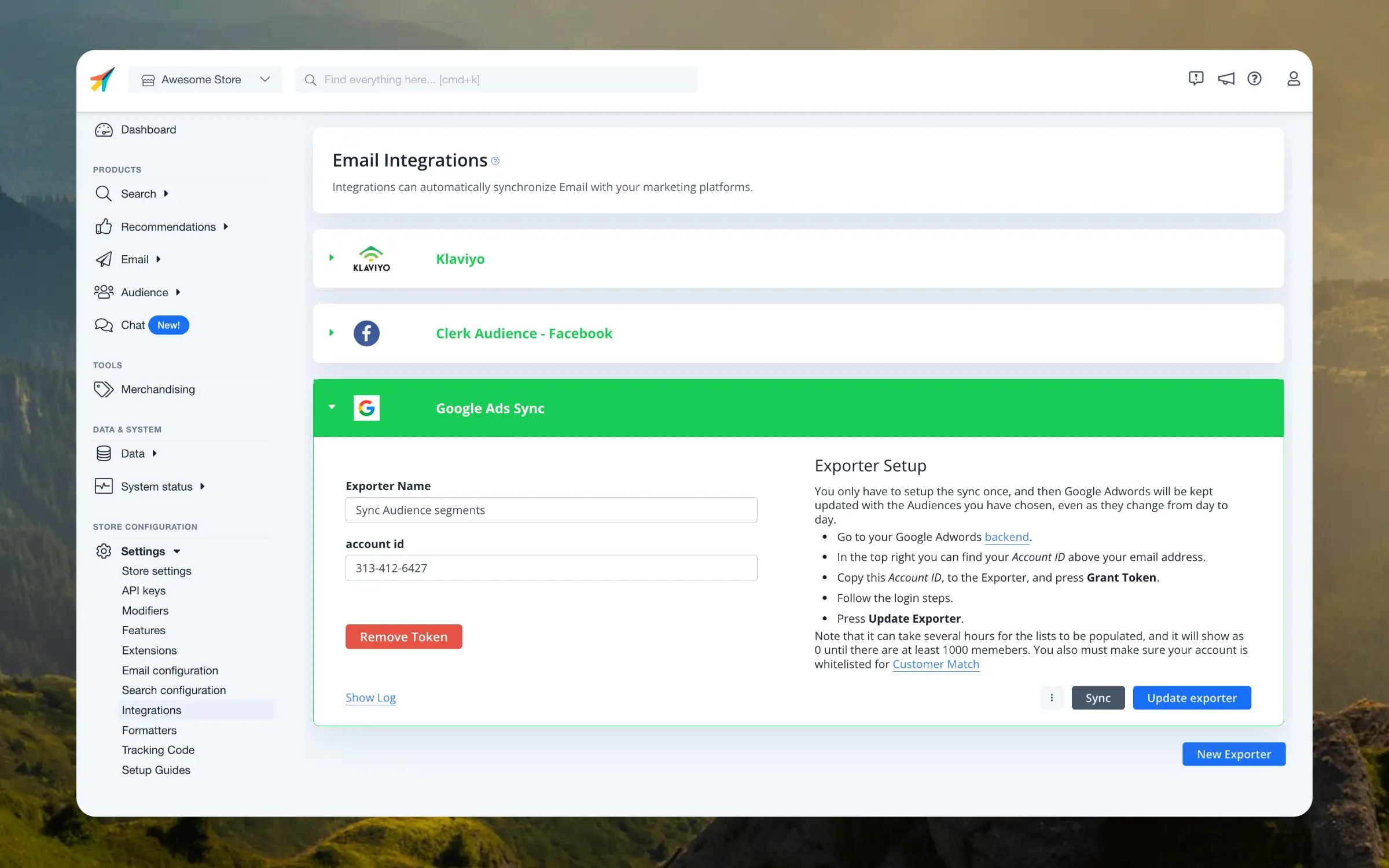
Go to Settings > Integrations and set up syncs between your:
- Email platform
- Google Ads account
- Facebook account
Each integration has a specific guide showing you what to do. Afterward, you will be able to sync to the platforms in Export on each Audience page.
Purchase Intent #
Interested In is the most advanced and unique feature of Audience. It allows you to easily find potential buyers for your products.
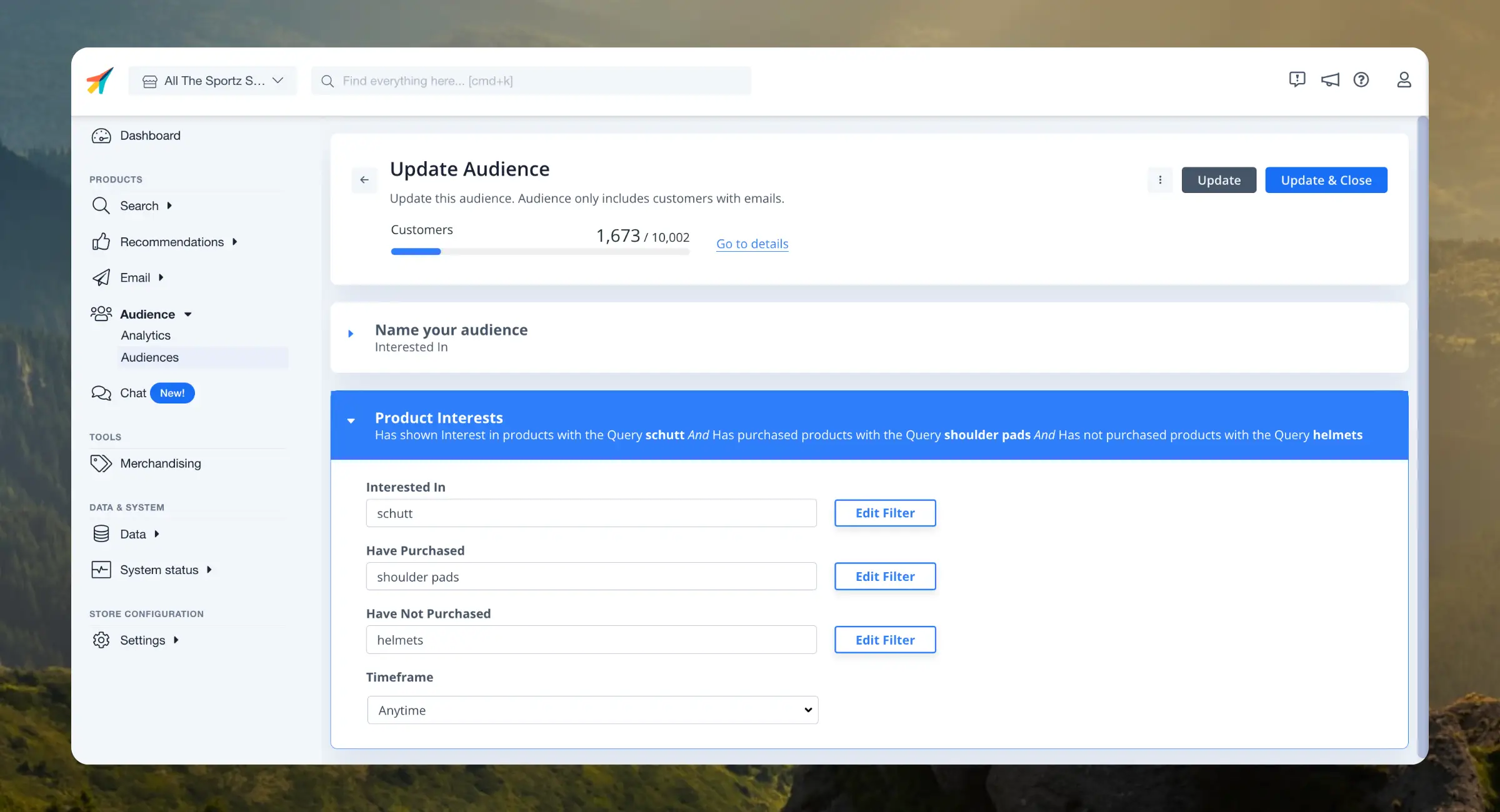
Clerk uses all order data from your webshop to predict what each customer is likely to buy next. Using this knowledge, you can create highly relevant marketing by promoting products to the customers who actually want to buy them.
Categories/Brands #
You likely have many different product categories and brands on your site for a reason. Consumers tend to favor specific types of products and brands that they have come to trust.
Marketing setup #
Choose 5-10 of your best unique categories and brands, such as:
- Shirts
- Sneakers
- Pants
- Sweatshirts
- Socks
- Nike
- Adidas
- Under Armour
- Vettex
- Hummel
Create individual Audiences with Interested In, using the keywords for these product types. You now have access to several segments of customers who are very likely to buy these products.
Sync each Audience to your email platform, and send emails that show products from these categories and brands. Because you know which items will be shown in each, you can tailor your subject lines to clearly mention them.
You now have a very effective email marketing strategy for reaching out with products that are actually interesting to each customer.
If you have Clerk’s Email product, you can also set up Recurring emails using our Recommendations Based on Keywords logic, by simply writing the name of the category or brand. This allows you to send highly relevant emails regularly to all of the Audiences you create.
You should also sync these Audiences to your Google Ads account. With them, you can target Audiences with products from each category, which highly increases the chances of them clicking and going to your site.
Longtail Products #
Many webshops tend to only market the “safe” products that most customers are likely to buy. However, this means missing out on a lot of sales potential, as you almost certainly have customers who want to buy the more special longtail products.
For example, jewellery stores mostly sell necklaces, rings, and earrings, which means they likely won’t send marketing material around their Star Wars Swarovski crystal figurines.
Using Interested In, you can find all customers who want to buy these longtail products, which significantly increases your email revenue potential.
Marketing setup #
Identify 5-10 longtail products or categories that you otherwise would not market, and create Audiences with Interested In for these. Then send emails showing those, just like with the categories and brands.
If you have Clerk’s Email product, you can also set up Recurring emails using Recommendations Based on Keywords just like your category and brand-based emails.
Further, sync the Audience to Facebook and Google, then create product campaigns around them to get more potential customers to see them.
Cross Selling #
Customers often place orders without buying that one great accessory that you know they will need. Maybe they purchased a brand new tent but forgot the crucial mosquito repellent that will make the trip actually enjoyable.
Marketing setup #
Combine the features Have Purchased with Have Not Purchased to create an Audience of customers you can very likely cross-sell to using your industry expertise.
Maybe you want to find customers who have purchased a bike but not a lock, or a new guitar but not a gig bag.
Use this Audience in your email marketing and ads to show the accessories they absolutely need to buy.
Customer Data #
Segment your audience using customer attributes imported from your database. E.g. Create segments based on subscribed customers, and language preferences, if available.
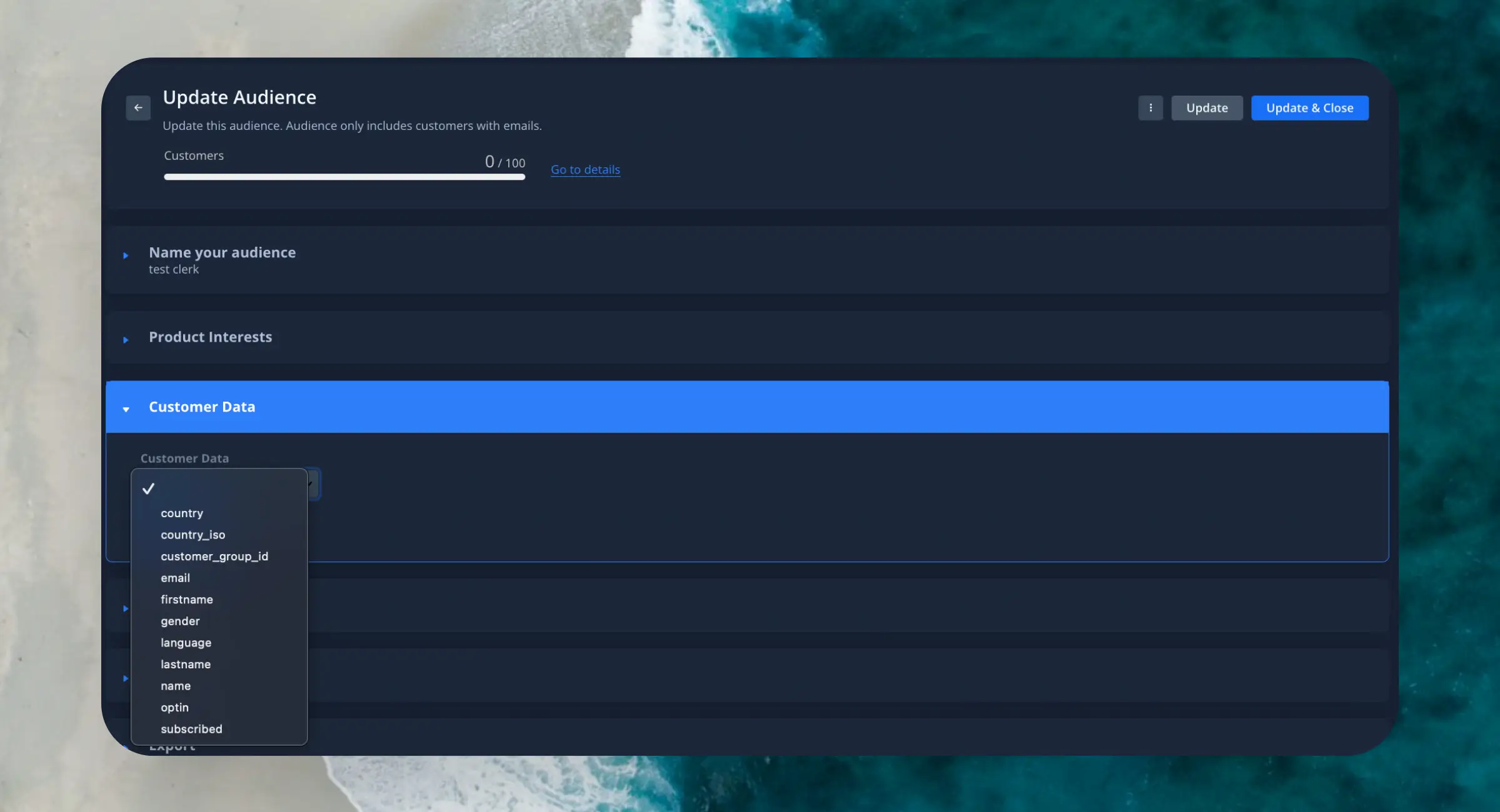
Behaviour #
Behaviour segments by purchase frequency to let you market to customers based on how often they buy, and how their behaviour changes over time.
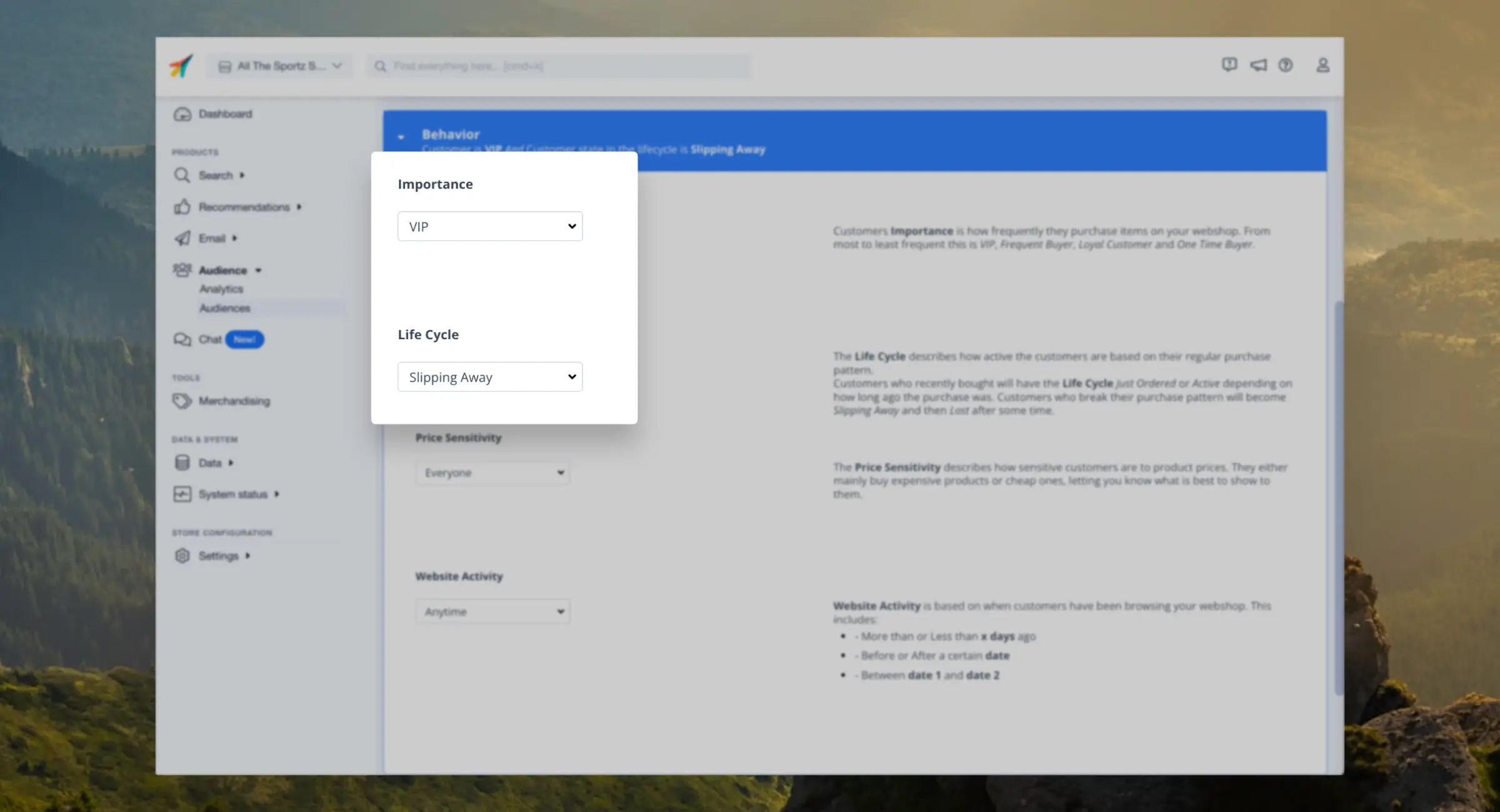
Importance #
Audience segments customers into Importance groups based on their orders:
- One Time Buyers
- Loyal Customers
- Frequent Buyers
- VIPs
One Time Buyers are simple, as they have purchased only once. The remaining groups change and develop over time as Clerk continuously predicts the orders and revenue to define each group.
One Time Buyers are important to reactivate, as it’s much cheaper to get existing customers back than acquiring new ones. We often see up to 70% of a webshop’s customer base consisting of One Time Buyers.
In your email platform, set up flows targeting One Time Buyers with personalized recommendations, news, posts, and any other incentives to keep them reminded of you.
VIPs are your most valuable customers and should be treated as such. They place the most orders and spend the most money with your business. They often generate as much as 20% of your overall revenue, so keeping them engaged is extremely valuable.
Marketing setup #
Create separate Audiences for One Time Buyers and VIPs.
In your email platform, send personalized emails at regular intervals, and if possible, include special offers, early access to products, and any other extras to make them feel special.
Your VIPs can also work as the foundation for finding new, similar customers who might not know about your webshop yet. Sync them to Facebook and use their Lookalike Audience feature to promote your ads to customers with similar interests to your VIPs.
Life Cycle #
Your customers are not equal, and neither are your recipients. Some are worth more to you than others, and some are more critical to reactivate than others.
That’s what Life Cycle is great for. It helps you find groups of customers to focus on reactivating.
Clerk’s AI continuously predicts Life Cycle patterns - They are fully dynamic and will change as each customer’s behavior changes.
For example, a customer who purchases every three months will be classified as Slipping Away after four months of not purchasing. A customer who only shops once a year will still be Active even if they have not purchased for nine months.
This can be used to your advantage by setting up automated reactivation flows.
Marketing setup #
Create Audiences for Slipping Away and Lost. Then set up a flow in your email platform that sends out an email to everyone in these Audiences and continues to send emails as new ones enter them.
These emails should focus on giving these customers incentives to come back if they forgot about your webshop or found a competitor.
You could give them a discount code valid for a short period, or a free product if they shop within a certain number of days.
Combine this with showing personalised recommendations, such as using Clerk’s Email Recommendations logic Recommendations Based on Orders, to show them something they are likely to find interesting based on their previous purchases.
Generally, you should have a more aggressive approach toward Lost customers, as they have not purchased in such a long time that they likely won’t return unless reactivated. This means higher discounts, better giveaways, or anything else you can do to provide incentives.
Slipping Away should also receive some benefits for returning, but they are generally easier to reactivate.
Combinations #
Audience lets you mix & match any of the features into very unique segments.
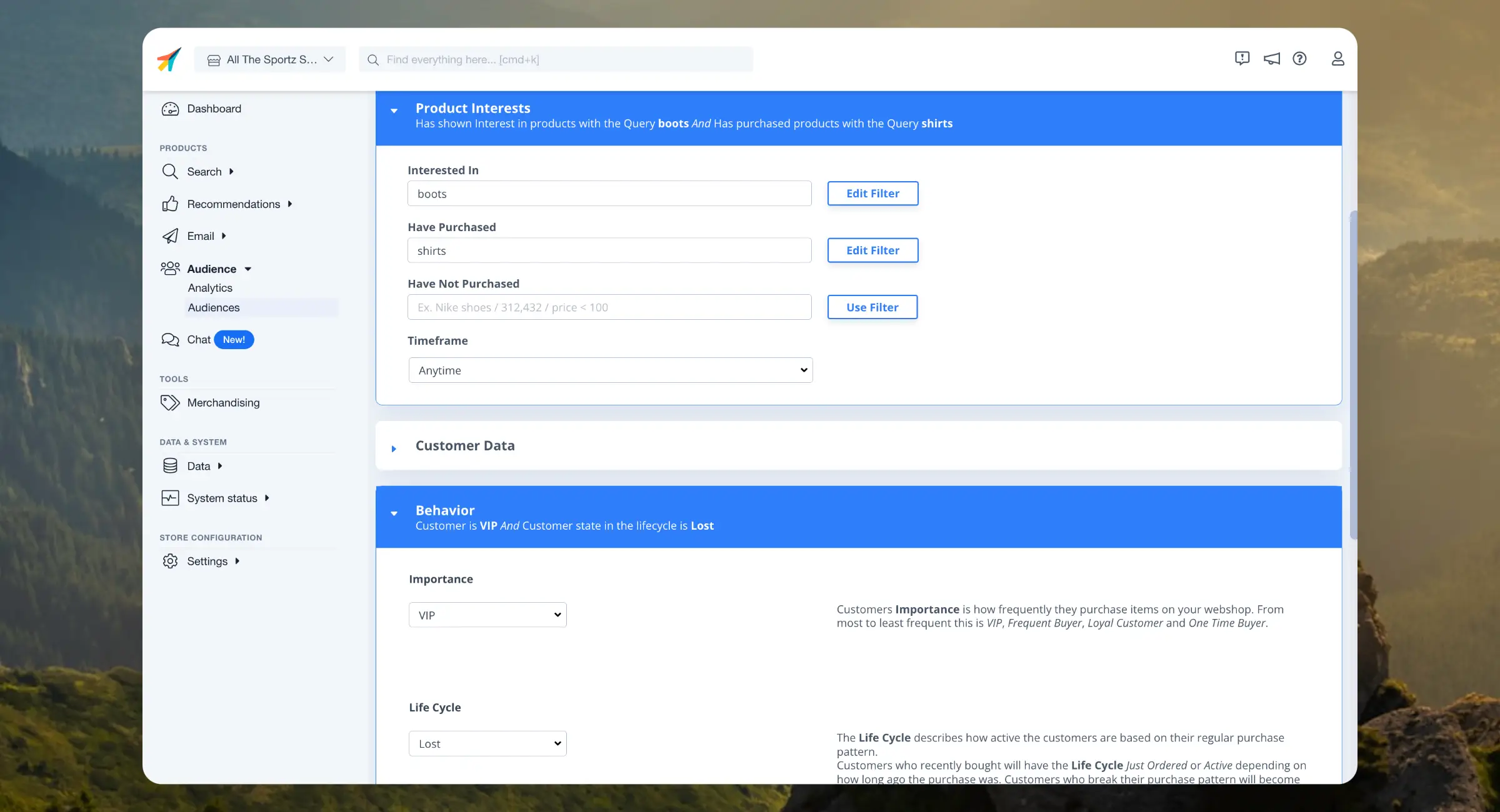
For example, you can create a special campaign for your VIPs who are Lost, or One Time Buyers who are interested in buying the new Nike sneaker you just got in stock.
Combining the different features makes your segments even more specific which will lead to more conversions when you show them what they want to see.
Optimize Regularly #
Clerk’s AI updates Audiences based on customer behavior at all times, but there will be cases where a human touch is needed to take your results to the next level.
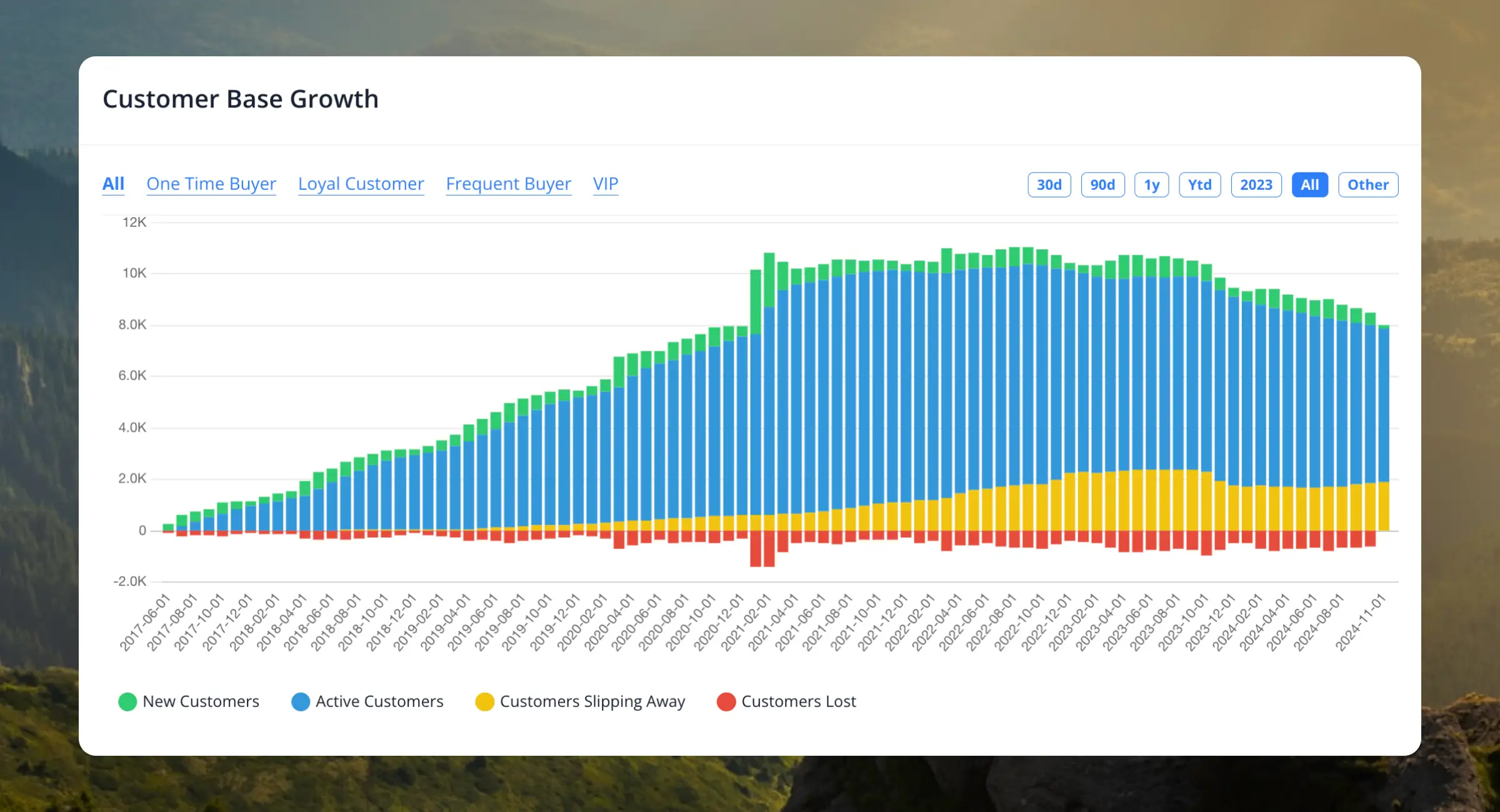
Analytics #
This is your go-to place for an overview of your entire customer base. It lets you spot both positive and negative trends in your customers’ behavior, like the number of active customers you have today compared to last year, how many are slipping away, and more.
With this knowledge, you know whether things are going in the right direction, or if you need to plan reactivation campaigns and other marketing to keep your customers coming back.
As a rule of thumb, if you continously get more Active customers compared to previous months, your marketing efforts are working.
Segment Details #
Regularly check this dashboard to compare Audiences and find the ones with the most potential revenue.

This is especially useful for planning the advertisements that will generate the highest Return on Ad Spend.
We recommend checking at least once a month and finding 3-5 Audiences with different category, product, or brand interests and focusing on those with the most potential revenue.
If your priority is getting a large but temporary boost in revenue, focus on those with the highest historic revenue, as these will often contain the most customers.
If your priority is long-term customer engagement, focus on the Audience with the highest lifetime value, as these will often have fewer customers who, in turn, spend more and buy more often.